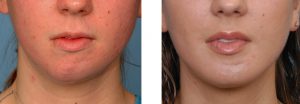Increasing the prominence or projection of a chin is a common aesthetic facial procedure. It can be of great benefit alone or in combination with such procedures as rhinoplasty, neck liposuction and facelifts. As the predominant and leading feature of the lower third of the face, the chin is one of the most important structural elements of one’s profile. A weak or strong chin casts an impression of one’s personal characteristics even though it may not be an accurate one.
In doing chin assessment and in considering before and after surgery results, the profile view is almost always exclusively shown. While the side view can demonstrate some dramatic changes, the amount of horizontal projection of the chin is but just one dimension. Even though it is the view that most people see us as (actually the oblique or three-quarter view is), we see and know ourselves more from a frontal view. This is how we see ourselves everyday in the mirror.
The forgotten view of the chin, so to speak, is the frontal view. What is relevant about the frontal view in chin augmentation is the width and shape of the chin. It is important to realize that there are chin shape differences between man and women just like there are differences in the amount of horizontal projection. While there are more chin augmentations that are done in men, I have observed there are higher rates of dissatisfaction in women. Many of these dissatisfactions are related to overprojection and the creation of too much chin width.

Understanding these gender chin differences is important for chin implant augmentation. Most of the chin implant designs are more male-oriented. The evolution of chin implants has most of them having extended or long lateral wing designs. While this is critical in male chin augmentation to create a wide and prominent extension of the chin back into the jawline, it is not always beneficial for females. Many women would be aesthetically better if the implant was more centrally tapered and had shorter lateral extensions, particularly the younger woman who has no aging jowl concerns.
In chin augmentation, many off-the-shelf implant designs exist. All of the materials can easily be modified by simple intraoperative shaping. Gender differences should be taken into account, not excluding the frontal view and how the implant may affect that important patient view.
Dr. Barry Eppley
Indianapolis, Indiana



